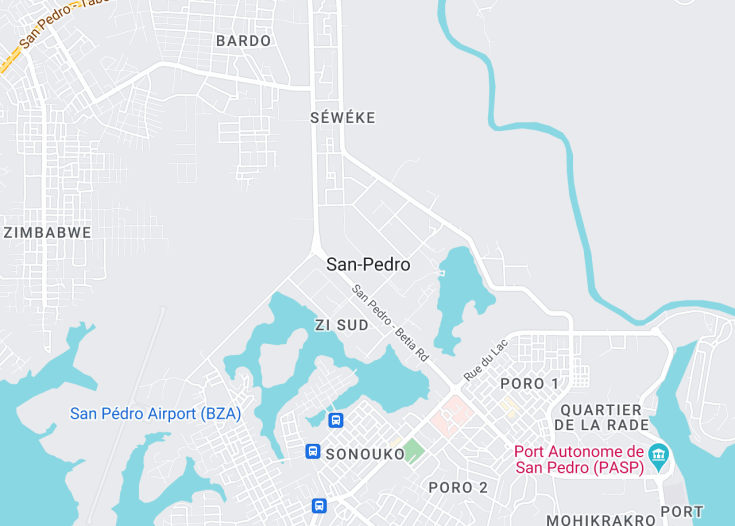San-Pédro, situated on the southwestern coast of Côte d’Ivoire, is a vibrant port city known for its significant economic contributions and breathtaking scenic beauty. This city is not only a hub for cocoa exportation but also a gateway to pristine beaches and lush landscapes. Tourists are drawn to its bustling harbor, diverse cultural heritage, and nearby attractions like the lush Tai National Park and the tranquil waters of Grand-Béréby. San-Pédro offers a unique blend of economic vitality and natural splendor, making it an attractive destination for both business and leisure travelers.
Ensure to explore the bustling local markets in San-Pédro, where you can buy authentic Ivorian textiles and handcrafted goods.
Do not miss a visit to the nearby Tai National Park, home to a diverse ecosystem and many endangered species.
Top things to do & see in San-Pédro
Select the following sights and activities to discover best tickets and tours available in San-Pédro.
San-Pédro: Gateway to Ivory Coast’s Southwestern Treasures
| Country | Côte d’Ivoire |
| Time in San-Pédro | GMT-5 |
| Language spoken | French |
| Population | 261,616 (Source: Latest census data) |
| Currency | West African CFA franc (XOF) |
| Airports |
|
San-Pédro, nestled in the southwestern part of Côte d’Ivoire, is a vibrant city full of color and life. It serves as a major port town, holding vital economic significance for the country due to its extensive maritime links. The region around San-Pédro is rich with dense tropical forests, making it a hot spot for biodiversity and natural beauty. Culturally, the city represents a mix of indigenous groups and a legacy of French colonial history, which is evident in the local architecture and the prevalence of the French language among its inhabitants.
San-Pédro is often celebrated for its beautiful coastal landscapes and pristine beaches, which attract tourists from all over the world. The local economy thrives not only on port activities but also on fishing and tourism, creating a lively and dynamic local market scene. The city annually celebrates festivals that showcase its rich cultural tapestry, including music, dance, and traditional crafts which attract cultural tourism.
Historically, San-Pédro’s significance grew as a port hub for the export of cocoa, coffee, and timber, products that are mainstays of the Ivorian economy. Today, it continues to expand its infrastructure to accommodate growing international trade.
Where is San-Pédro?
San-Pédro is located on the southwestern coast of Côte d’Ivoire, bordered by lush rainforests and the Atlantic Ocean.
Distances:
| Route | Distance by car | Time by car |
|---|---|---|
| Abidjan to San-Pédro | 348 km | Approx. 6 hours 30 min |
| Yamoussoukro to San-Pédro | 459 km | Approx. 8 hours |
What is San-Pédro famous for?
San-Pédro is famous for its bustling port, beautiful sandy beaches, and vibrant cultural festivals. It’s a key economic and logistical hub in Côte d’Ivoire due to its strategic location.
History
Pre-Colonial Period (Before 19th Century)
San-Pédro’s tale began long before modern records, as a dwelling place for indigenous tribes of the region. The area now known as San-Pédro was primarily inhabited by the Kru people, who were known for their expertise in fishing and small-scale agriculture. Pre-colonial San-Pédro was a tapestry of dense forests and modest settlements, largely undisturbed by external influences.
Colonial Period (1880s – 1960)
In the late 19th century, San-Pédro drew the attention of French colonial interests aiming to tap into the rich resources of West Africa. By the early 20th century, San-Pédro was formalized as a colonial outpost. The establishment of administrative structures and the development of the port significantly altered the community’s socio-economic landscape, integrating it into the broader colonial economy primarily through the trade of coffee, cocoa, and timber.
Post-Independence Era (1960 – Present)
After Côte d’Ivoire gained independence in 1960, San-Pédro experienced substantial growth. The port city expanded its infrastructure rapidly in the latter half of the 20th century to become the second most important port in Côte d’Ivoire. This period was characterized by significant urbanization and economic development, with modern facilities emerging and a growing population seeking opportunities. Today, San-Pédro is not only a major economic hub but also a cultural melting pot, reflecting a blend of indigenous and external influences accumulated over decades.
Visit San-Pédro
What to see and do in San-Pédro, Côte d’Ivoire
San-Pédro, a vibrant port city, offers a mix of captivating activities and sites:
- Explore the lively local markets teeming with colourful crafts and fresh produce.
- Visit the sweeping beaches that line the coast, ideal for relaxation or water sports.
- Take a boat tour to experience the beauty of the coastal ecosystems and perhaps catch sight of local marine life.
- Engage with the city’s rich cultural heritage by attending traditional music and dance performances.
Festivals and Events in San-Pédro
San-Pédro hosts several cultural and music festivals throughout the year, notably the San-Pédro Music Festival held every summer. These events showcase local and national artists and are a celebration of Ivorian music, dance, and cuisine, drawing both locals and tourists alike.
Best time to visit San-Pédro
The ideal time to visit San-Pédro is during the dry seasons, from May to July and December to March. These periods offer sunny days and minimal rainfall, ideal for exploring the city and enjoying the beaches.
Is San-Pédro worth visiting?
San-Pédro is a destination with a rich historical background and a thriving cultural scene. Its appealing aspects include beautiful beaches, a range of cultural experiences, and access to natural landscapes. However, potential visitors should be aware of the wet season, which might restrict outdoor activities. Overall, San-Pédro offers a unique experience that can cater to the interests of many travelers, making it certainly worth a visit.










